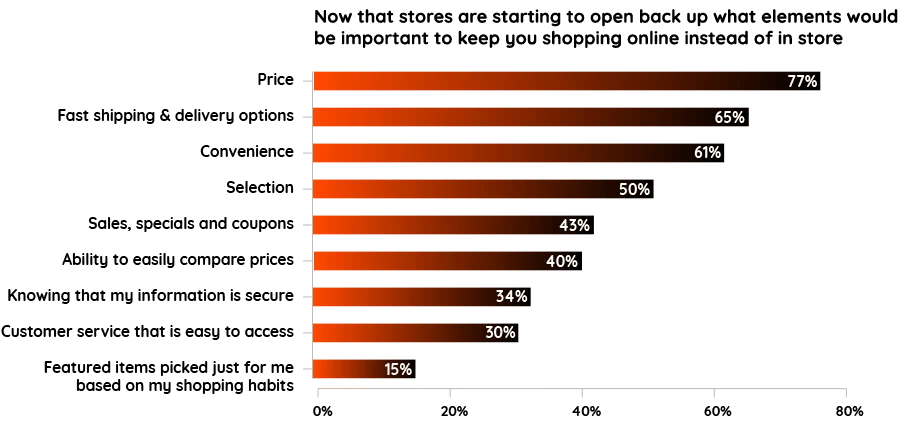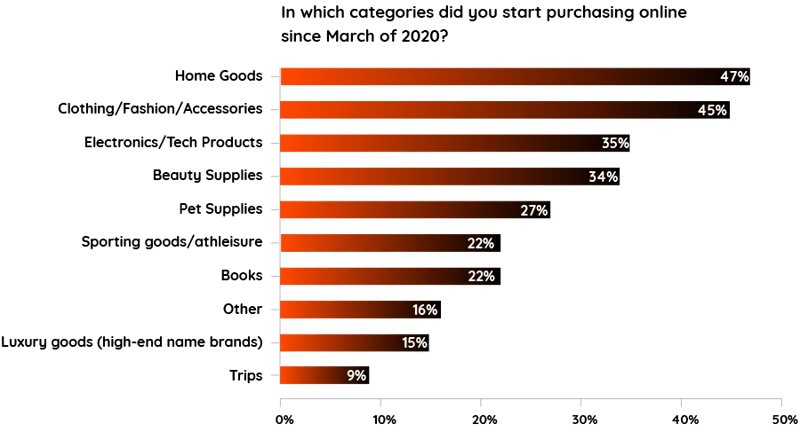Ecommerce Growth is Slowing. It’s Time to Review Your Online Marketing Strategies and CX
Ecommerce saw record-breaking gains in 2020. In 2020, according to ClearSale’s State of Consumer Attitudes, CX & Fraud Survey, 78% of consumers in the U.S., Canada, Mexico, Australia and the U.K. spent more online and/or made purchases more often online than pre-pandemic, and 30% of those who reported spending more said their average online spend increased by more than $400 per month. The result was a profitable but hectic time for online sellers who had to balance staffing, supply chain and customer experience challenges along with rapid growth.
Now, ecommerce is still in growth mode, but more slowly than last year. Compared to Q2 2020, in-store sales increased in by over 20% while online growth “slowed significantly” Q2 2021. As brick-and-mortar stores reopen and vaccinated shoppers return to them, online merchants now have to compete with both digital and physical stores on customer experience, product selection and other factors. That makes it a good time for online retailers to take stock of which marketing strategies are working, which CX elements need improvement, and what needs to happen next to keep customers coming back.
Focus on the factors that your online customers care about
We asked survey participants what would keep them shopping online instead of returning to brick-and-mortar locations now that stores are reopening in many regions. The top reasons, cited by more than half of the respondents, are price, fast shipping and delivery options, convenience and selection.

Competitive pricing is always a challenge, especially when supply chain reliability is uncertain. However, clear communication about the total cost of an order can improve the customer experience. More than half (51%) of the surveyed consumers said they’ve abandoned carts online because of extra costs or fees they learned about only during checkout.
Shipping costs and speed matter so much to customers that 69% of the survey participants said they’ve abandoned online carts because shipping cost too much or would take too long. Offering multiple shipping options at different price points and speeds can make it easier for your customers to find an option that meets their needs.
Convenience is a term that covers a lot of customer-experience ground, from site speed and navigation to the checkout process. Thirty-five percent of surveyed consumers said they’ve abandoned carts because the online checkout process was too long or too complicated. Thirty-two percent said they’d ditched a cart because the merchant required them to create a customer account before they could complete their purchase.
Streamlining the checkout process can reduce abandonment by creating a better experience for your customers. Start by analyzing your site analytics for your checkout. At which points in the process do customers drop out most often? Those are the steps to address first. For example, you may find that requiring customers to key in their shipping address and billing address even if it’s the same address for both causes many shoppers to give up. Enabling customers to tick a box to use their billing address as their shipping address may reduce dropouts here.
Or you may find that customers get all the way to the card-number entry stage and then quit. In this case, you should consider adding a digital wallet payment option, so that customers don’t have to get their card and perform data entry. Thirty-six percent of survey respondents have abandoned carts because they didn’t trust the online store with their credit card number, and 71% sometimes or always use a digital wallet instead of a credit card to pay for their online purchases.
Review your marketing for the most popular new product categories
Once you’ve audited and updated your customer experience for the top reasons they shop online, you can also look at the way you present your products. Fifty-three percent of online customers in the survey said that since March 2020, they’ve made online purchases in categories that they hadn’t before. Among these shoppers, the most common new categories were home goods, clothing and accessories, electronics and beauty supplies.

Most products are more appealing to online shoppers if they’re shown in 3D, with good close-ups of the materials and colors and options for seeing how they’ll look in a customer’s home or being worn by the customer. Home goods, clothing and beauty products in particular can benefit from this kind of rich product information. For example, cosmetics retailers that let customers use interactive color-choice charts and save their preferred shades and brands can win more sales because shoppers buy with more confidence that the makeup that they buy will look good on them. These tools can also reduce returns that cost your business money in reserve logistics and product waste.
Keep the cross-border customer experience in mind
In the consumer attitudes survey, 48% of respondents said they usually ordered from both local websites and those located in other countries, while 4% exclusively ordered from overseas sites and another 5% weren’t sure if the sites they shopped at were local or cross-border. As stores reopen, it may not always be possible for consumers to find local brick-and-mortar alternatives to their favorite overseas merchants, and they’ll have less incentive to search for alternatives if their experience is excellent at their favorite overseas retail sites.
In addition to the marketing strategies we’ve already covered, ecommerce merchants can also review their site’s localization options and performance. For example, do the language options on your site align with the traffic coming from other countries? Your site analytics can help you decide if you need to add more translation support, shipping options and payment methods for shoppers from other regions. For example, a Canadian merchant that offers English- and French-language versions of its website might find that it’s seeing more Mexican customers browsing the site. Giving them an option to see a Spanish-language version of the site could increase conversions and repeat visits.
By strengthening your store’s performance in the areas that make ecommerce appealing to shoppers, giving customers all the information they need to feel confident making online purchases of items like clothing and home goods, and expanding your store’s appeal to cross-border shoppers, your store can continue to grow even as in-store shopping returns.
Original Article: https://customerthink.com/ecommerce-growth-is-slowing-its-time-to-review-your-online-marketing-strategies-and-cx/
 Sarah Elizabeth
Sarah Elizabeth